Suonenjoki 作者: 来源: 发布时间:2021-10-16
一、所属省或是州,具体位置,人口,面积
Suonenjoki is a Finnish city located in the western part of Pohjois-Savo province. In living 7 018 people, and a surface area of 862.34 square kilometer 148.79 sq km is water. The population density is 9.84 inhabitants / km². The neighboring municipalities of Suonenjoki are Kuopio, Leppävirta, Pieksämäki, Rautalampi and Tervo. The center of Suonenjoki is located near the river Suonenjoki.
The main industry in Suonenjoki is strawberry growing, which is also visible in the city's coat of arms. Suonenjoki is the only city in the Sisä-Savo region and the municipality with the largest population. Suonenjoki received municipal rights in 1865. The township Suonenjoki came in 1967 and was given city status in 1977, when the municipal law changed and kauppalajärjestelmä abolished.
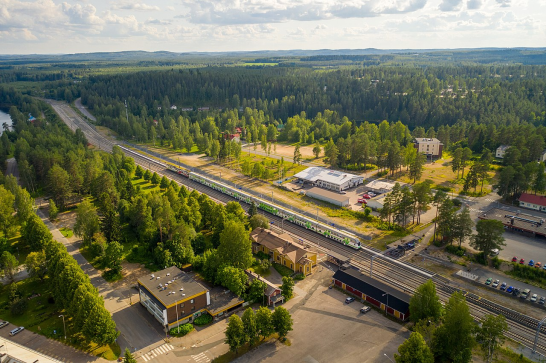
https://www.suonenjoki.fi/
二、自然地理
1.地理条件
Suonenjoki is located along Highway 9, 50 km southwest of Kuopio and 100 km northeast of Jyväskylä . The neighboring municipalities of Suonenjoki are Kuopio, Leppävirta, Pieksämäki and Rautalampi, as well as Tervo. Suonenjoki flows through the city from Lake Suontee to Iisvete. The scenic Lintharju is located near the city center. The city center consists of the Iisvesi – Käpylä – Suonenjoki axis.
Highway 9, which passes the Suonenjoki River, offers good road connections to Kuopio and Jyväskylä. The city also has good rail connections and runs through the city daily. In January 2006, VR started Pendolino connections to Helsinki and Kuopio. Suonenjoki Travel Center is located at the bus station and buses depart from there to Jyväskylä, Kuopio, Rautalammi, Karttula and Mikkeli.
2.交通情况
Suonenjoki is situated between two important cities, Kuopio and Jyväskylä, and the main road 9 (E63) between those cities goes through Suonenjoki. The railway between Kuopio and Helsinki goes also through the center of Suonenjoki.
三、经济发展和规模
The City of Suonenjoki's financial statements for 2019 have a surplus of approximately EUR 170,000. This was already the historical 6th consecutive year that the city has made a surplus. The cumulative surplus buffer in the balance sheet is close to 7.8 for the future Mill. euros. However, in such exceptional times, the city’s result has not come in any way by exceptional means. Growth in the income base was a key factor in the surplus result for 2019. Tax-based (tax revenue and government contributions) financing increased by more than +2.0 Mill. euros from a year ago. Tax revenue alone was on the rise +1.3 Mill. EUR, ie about + 5.4% year-on-year.
The city has not had to save. We have been for the last two years (years 2018 and 2019) used more than +4.0 Million to maintain our good service structure. EUR more than in 2017. As in 2018, growth will also increase for 2019 The cost structure generated about +2.0 Mill. euros. The number of our permanent employees increased with more than ten employees. The services are in good condition and faith in the future is strong.
The economy of the city of Suonenjoki has reached a balance in terms of covering deficits. Expenditure growth has been curbed, especially in 2015-2017. The better-than-expected and surplus result in 2019 brought additional time to adjust for a career structure that is more sustainable than the city’s economy. The challenge for the future is to reconcile, on the one hand, the growing need for services of the aging population and at the same time adapting services to the declining number of children and young people.
The city of Suonenjoki's net expenses (operating margin) are more than +1,000 euros per inhabitant at a higher level than the municipal average. This means more than +7 million Euros more costs per year than the municipal sector on average spent per year. After six years of surplus, the city's economy has about +7.7 million Euros ‘surplus buffer’. Surpluses based on the updated financial plan sufficient until 2024 at the latest. Achieving economic equilibrium in the medium term requires that the increase in operating expenses be kept below average + 1.5% growth / year. The positive development of the economic outturn cannot be only trust, but active and concrete decisions are needed on what to do. The city's operating economy has more than 1.0 million Euros in the need for immediate adjustment for the period 2020-2021.
The city of Sounenjoki (2019). 2019 Financial Statement. https://www.suonenjoki.fi/paatoksenteko/talousarvio_ja_tilinpaatos
四、产业特点/重点项目
In 2015, there were 2,452 jobs in the municipality. Of these, 8.7% were in primary production (agriculture, forestry and fishing), 61% in services and 28% in processing. The share of service was lower than in the whole country (75%), and the share of primary production was higher than in the whole country (3%).
Companies in the Suonenjoki area are organized into Suonenjoki Entrepreneurs, which is the local association of Savo Entrepreneurs. Major employers Suonenjoen region are the city and the Inner Savo health care federation of municipalities, inter alia, road maintenance equipment manufacturer Arctic Machine, liimapuupalkkivalmistaja Finland Laminated Timber, Iisveden Timber Oy's sawmill, Cooperative Milk Earth's dairy, Pakkasmarja Oy and Valio Oy Suonenjoki hillotehdas (formerly Nordic Jam Ltd). During the summer, a large number of strawberry pickers arrive in Suonenjoki from both Finland and abroad. The operating unit of the Finnish Forest Research Institute is also located in Suonenjoki.
Suonenjoki has built a state of the art business park. At Futuria Business Park, you can organize customer events, meetings, negotiations and trainings. In addition, it is possible to rent product development facilities or office space for your company.
五、风景名胜,景点( attractions)
1. Sounenjoki Church
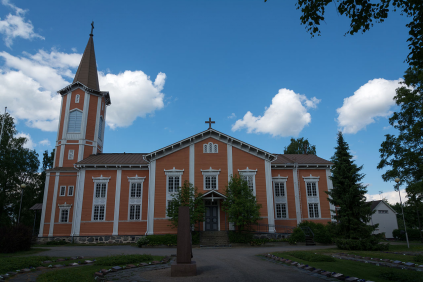
Suonenjoki Church is the church of Suonenjoki Parish, which was completed in 1865. It was designed by the county architect Ferdinand Öhman.
The church is a log- built long tower with a short transept. The church is 33 meters long, 23 meters wide and ten meters high. The height of the tower is 37 meters. The church received boarding both inside and out in the late 19th century, and it was also painted and equipped with fireplace heating. Crowns were acquired for the church, which were electrified in the 1920s.
The major renovation of 1955–1956 fundamentally changed the look of the church. The renovation was designed by architect Kauno Kallio. At that time the decorations were removed, the altar wall was paneled and the church was painted quite expressionless. During the renovation of 1993–1995, the color of the exterior painting of the church was restored to the original assumed color. In the context of the interior renovation, the goal was to go back to the 1920s in a certain spirit. The main designer was Aulis Jääskeläinen Architects from Seinäjoki.
The altarpiece painted by Helena Westling dates from 1884.
https://www.suonenjoenseurakunta.fi/kirkko-ja-tilat/kirkko
2. Kuivataipale canal
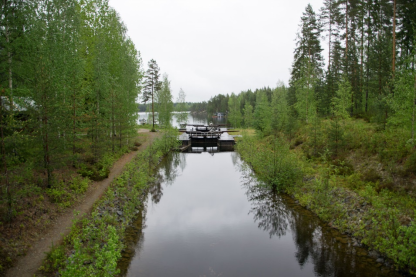
The Kuivataipale canal is a museum canal located in Suonenjoki, reopened in 1996, which connects the Vuoksi watershed and the Kymijoki watershed. This canal in Savonselä is the only canal connecting two water bodies in Finland. Originally, this 300-meter-long water connection between Paasvesi and Kuvans was built in the 1860s by Hackman for wood cutting. Between 1890 and 1891, locks were added to the canal, which were in use until 1951. The locks enabled shipping from Hackman's Sorsakoski mills by rail to the center of Suonenjoki.
The canal was completely discontinued in the 1960s. The canal was renovated by the National Board of Antiquities in 1994-1996, after which it was re-introduced to water transport. The current closing chamber is 19 meters long and five meters wide, and the closing gates are operated manually.
https://fi.wikipedia.org/wiki/Kuivataipaleen_kanava
3. Strawberry Carnival
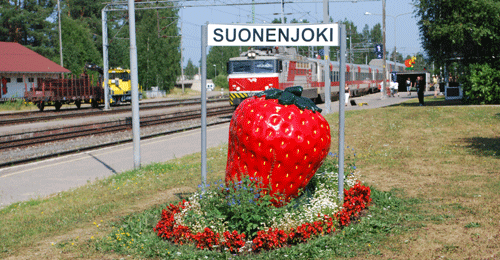
The Strawberry Carnival is an annual free event held in Suonenjoki that coincides with the ripening of the strawberry crop. Carnivals have been held annually since 1970 for two years, 1984 and 2003, with the exception of.
The venue for the carnival has been the Kaatro school field since 2008. The executive director of the event is Pertti Nyyssönen. During the event, among other things, a Strawberry Girl will be selected and a strawberry eating competition will be held.
Strawberry Carnival is the only Entertainment Event held in Finland that does not sell admission tickets. The event is sponsored by the local business community and the city of Suonenjoki, and the team raises revenue through advertising sales, marketplaces and a carnival restaurant. On Friday night, a carnival procession will run through the city, where companies can showcase their activities and craftsmanship. In 2011, it was estimated that there were as many as 10,000 spectators along the street. Entertainment artists perform on the carnival stage. In 2011, e.g. Jani Jalkanen and His Orchestra. The carnival program also included the strawberry church and the unveiling of a monument to the artist Kari Tapio. It is estimated that more than 20,000 guests have visited the locality throughout the weekend.
The Suonenjoki strawberry carnival also appears in Finnish literature. In Seppo Heikkinen 's novel The Strawberry Carnival, the events of the 1978 Strawberry Carnival move.
六、历史文化
1.历史
In the Suonenjoki area, Koskelovesi's Saunaniemi, comb-ceramic finds suggestive of settlement have been found, dating to about 2500–2000 BC. At that time, however, the area was mostly inhabited by Lapland migrants to the north.
The Suonenjoki River is thought to have served as a milestone in the Peace of Pähkinäsaari 1323. In the 16th and 17th centuries, more and more people began to change in the area, and in the 18th century, a prayer room was established in Suonenjoki, then a chapel congregation. In 1811, the chapel parish joined the parish of Rautalammi, as a result of which the administration concentrated on Kuopio instead of the former Pieksämäki. In the current agglomeration, the bridges over the Suonenjoki were built early, the Kruununs Bridge already existed in 1780 and the Zion Bridge at the beginning of the river was replaced by a bridge in the 1830s.
When Suonenjoki gained municipal rights in 1865, the population was about 4,000. In the same year, the current church in Suonenjoki was completed, replacing the cramped first church built in the late 18th century. A railway station was built on the Suonenjoki River in connection with the completion of the Savo line in 1889. A station was also built on the Iisvesi side line at the same time. The church village of Suonenjoki became a densely populated community in 1915 and Iisvesi in 1926. The church village was restored to the municipality as early as 1937, but the community of Iisvesi existed until the end of 1955. The sawmill industry became the most important industry in the region in the early 20th century. Strawberry cultivation became more common since the 1940s, and the Suonenjoki River became known as the city of strawberries. The Suonenjoki Co-educational School began operations in 1930, and it moved to the current high school building in 1950. Due to lack of space, an additional wing was built in 1956 and the school was renamed the Suonenjoki Co-operative Association.
A train accident south of Suonenjoki station occurred on 12 August 1998, when an InterCity train from the north and a freight train from the south collided. The accident slightly injured 25 people and seriously injured one.
2. 文化体育
Suonenjoki is famous for its strawberries. It is also known as "the Strawberry Town". Lots of foreign people, mainly from Ukraine and Russia, come to Suonenjoki in summer to work on strawberry farms. That makes Suonenjoki the most international town of Finland at summer. There is a party in Suonenjoki in July called Mansikkakarnevaalit, "Strawberry Carnival". There was also a rock festival named Jörisrock, the last "Jöris" was held in 2006. Nowadays, "Jöris" has been replaced by a music event called Iisrock. There is also three museums, library and artshow.
There are three museums in Suonenjoki (Kuivataipale Museum Canal, Kolikkoinmäki Workers' Home Museum and Suonenjoki Homeland Museum), a library and an art gallery. The library and art gallery, Kellarikalleria, are located in the same building as the Suonenjoki cultural service. The city also has the Sisä-Savo Citizens' College, which organizes general adult education.
Paikallislehti Sisä-Savo is published in Suonenjoki and the surrounding municipalities. The magazine was first published in 1965 as the local newspaper Rautalammi – Suonenjoki.
七、其他信息
There are numerous sports clubs in Suonenjoki, the largest of which are Suonenjoki Kiekko-Karhut (SuKiKa) and Suonenjoki Pallo (SuPa) and the general club Suonenjoki Vasama, founded in 1908.
Suonenjoki Kiekko-Karhut is a sports club that has focused its activities on hockey and ringing. SuKiKA's Team A plays in the 4th block of the Hockey II Division, where the team has been doing well recently. SuKiKA also has a comprehensive junior program, there is a team in every age group and people over the age of 17 usually move to the A-team or other teams. SuKiKA's traditional colors are black and yellow. The team will play its match in the ice rink completed in 1997 in Suonenjoki.
八、联系方式
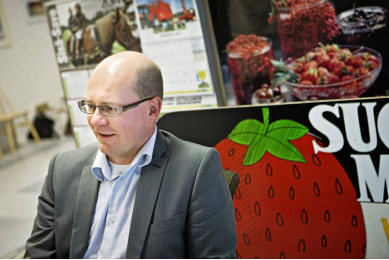
Mayor: Juha Piiroinen
Telephone: +358 (0) 17 513 311
Email: juha.piiroinen@suonenjoki.fi
https://www.suonenjoki.fi/kuntainfo/yhteystiedot_ja_asiointi/henkiloston_yhteystiedot?i=76
